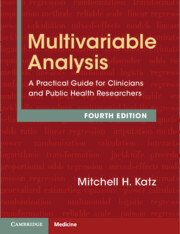Book contents
- Multivariable Analysis
- Multivariable Analysis
- Copyright page
- Contents
- Preface
- 1 Introduction
- 2 Common Uses of Multivariable Models
- 3 Outcome Variables in Multivariable Analysis
- 4 Independent Variables in Multivariable Analysis
- 5 Relationship of Independent Variables to One Another
- 6 Setting Up a Multivariable Analysis
- 7 Performing the Analysis
- 8 Interpreting the Results
- 9 Delving Deeper: Checking the Underlying Assumptions of the Analysis
- 10 Propensity Scores
- 11 Correlated Observations
- 12 Sensitivity Analysis
- 13 Validation of Models
- 14 Special Topics
- 15 Publishing Your Study
- 16 Summary: Steps for Constructing a Multivariable Model
- Index
9 - Delving Deeper: Checking the Underlying Assumptions of the Analysis
Published online by Cambridge University Press: 09 October 2025
- Multivariable Analysis
- Multivariable Analysis
- Copyright page
- Contents
- Preface
- 1 Introduction
- 2 Common Uses of Multivariable Models
- 3 Outcome Variables in Multivariable Analysis
- 4 Independent Variables in Multivariable Analysis
- 5 Relationship of Independent Variables to One Another
- 6 Setting Up a Multivariable Analysis
- 7 Performing the Analysis
- 8 Interpreting the Results
- 9 Delving Deeper: Checking the Underlying Assumptions of the Analysis
- 10 Propensity Scores
- 11 Correlated Observations
- 12 Sensitivity Analysis
- 13 Validation of Models
- 14 Special Topics
- 15 Publishing Your Study
- 16 Summary: Steps for Constructing a Multivariable Model
- Index
Summary
Assessing the underlying assumptions of multiple models enables us to improve their fit. But it is a complicated process that is more art than science. The basic measure to assess the fit of models is residuals. Residuals are the difference between the observed and the estimated value. They can be thought of as the error in estimation. There are a number of possible transformations of the residuals for different multivariable procedures. For proportional hazards analysis it is important to test the proportionality assumption. This can be done using a log-minus-log survival plot, Schoenfeld’s residuals, division of time into discrete intervals, or time-dependent covariates.
Keywords
Information
- Type
- Chapter
- Information
- Multivariable AnalysisA Practical Guide for Clinicians and Public Health Researchers, pp. 169 - 186Publisher: Cambridge University PressPrint publication year: 2025
Accessibility standard: Inaccessible, or known limited accessibility
Content Navigation
Allows you to navigate directly to chapters, sections, or non‐text items through a linked table of contents, reducing the need for extensive scrolling.
Provides an interactive index, letting you go straight to where a term or subject appears in the text without manual searching.
Reading Order & Textual Equivalents
You will encounter all content (including footnotes, captions, etc.) in a clear, sequential flow, making it easier to follow with assistive tools like screen readers.
You get more than just short alt text: you have comprehensive text equivalents, transcripts, captions, or audio descriptions for substantial non‐text content, which is especially helpful for complex visuals or multimedia.
You can access graphs or charts in a text or tabular format, so you are not excluded if you cannot process visual displays.
Visual Accessibility
You will still understand key ideas or prompts without relying solely on colour, which is especially helpful if you have colour vision deficiencies.
You benefit from high‐contrast text, which improves legibility if you have low vision or if you are reading in less‐than‐ideal lighting conditions.
